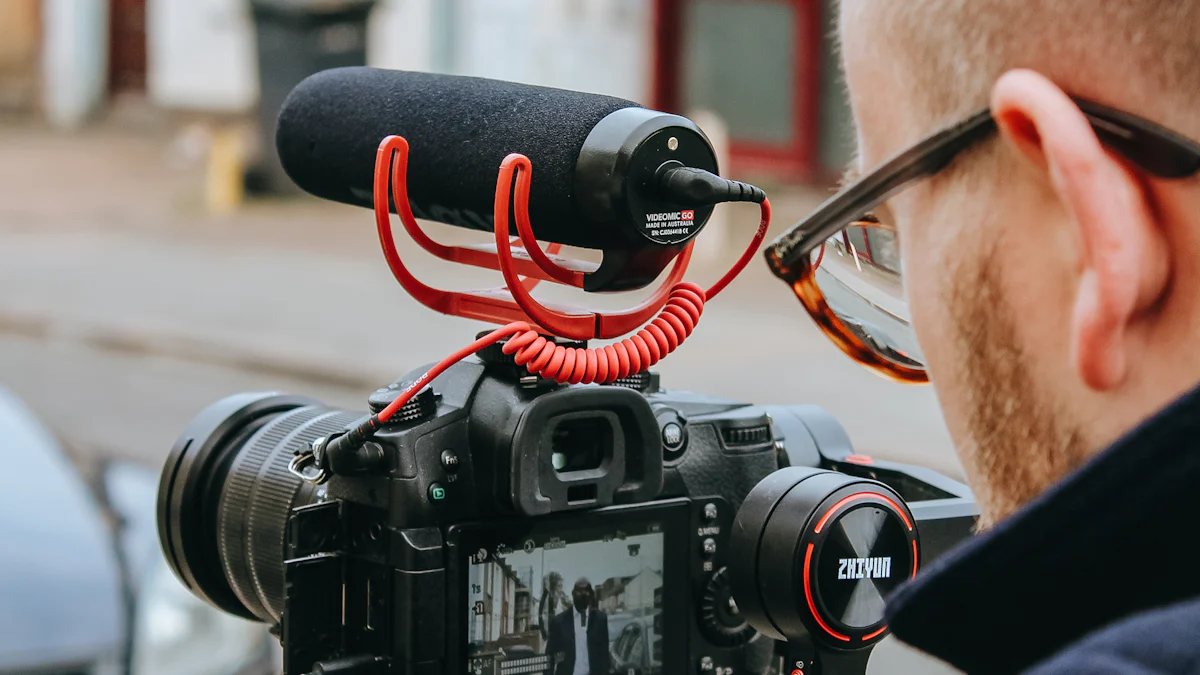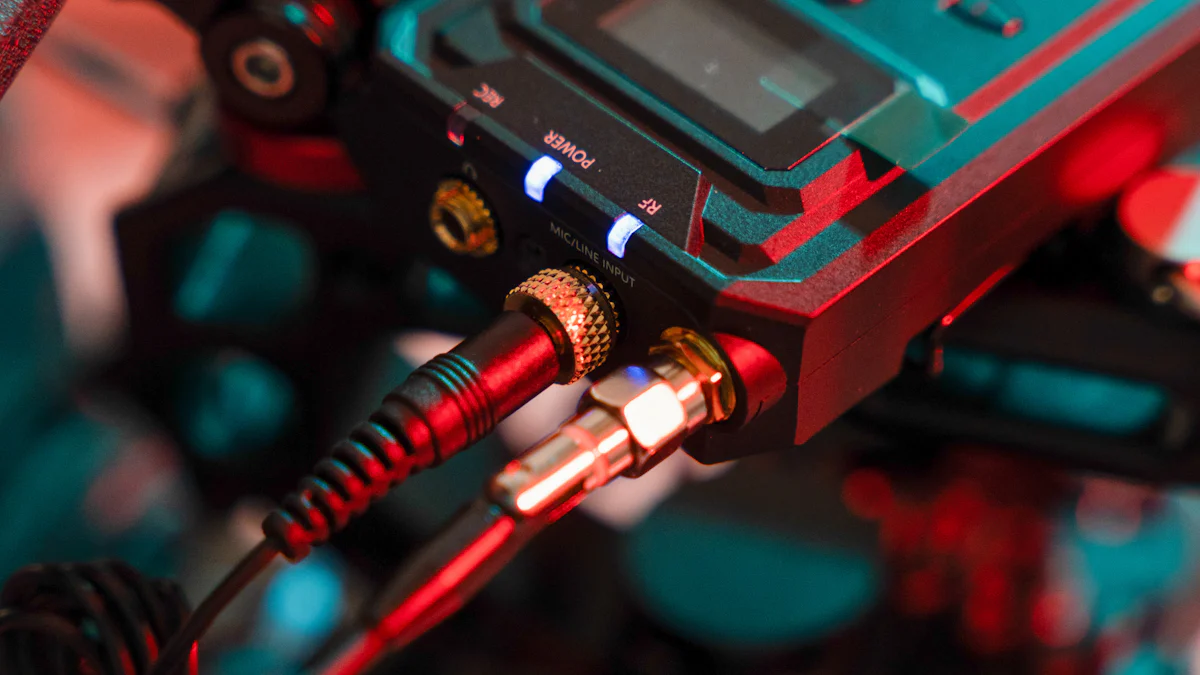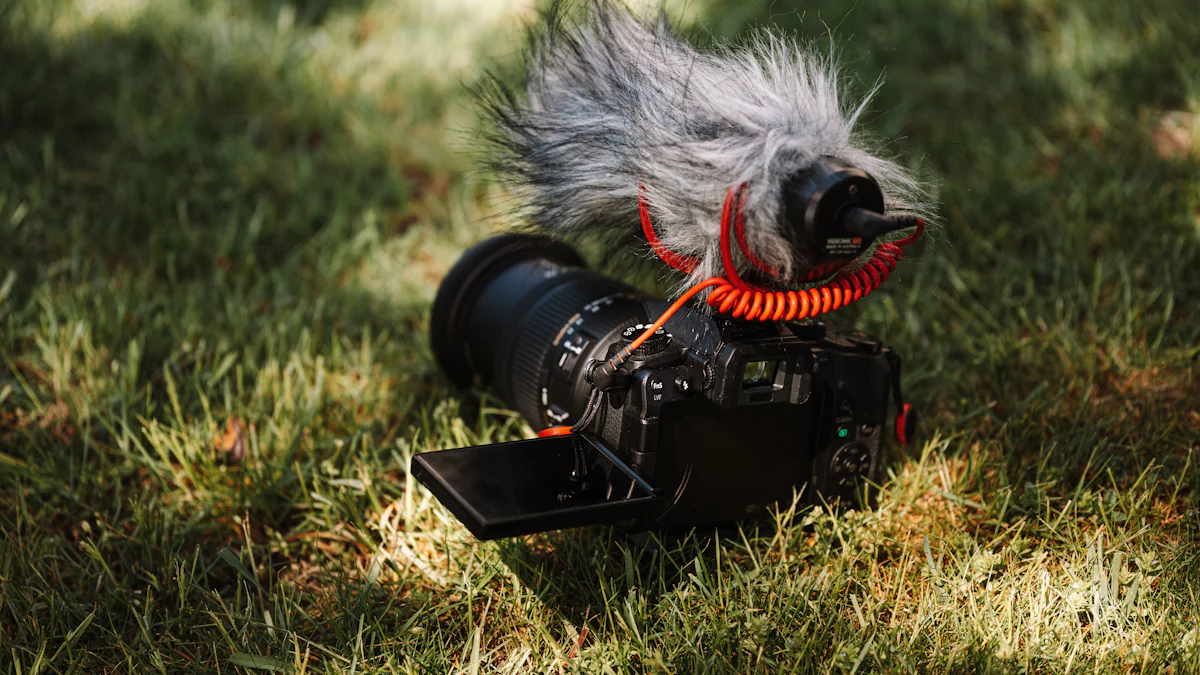How to Enhance Your Zoom Audio Experience

In today's virtual world, improving your Zoom audio quality is crucial for professional calls. Clear audio directly impacts how effectively you communicate. Poor sound can lead to misunderstandings and frustration. Many users face issues like unwanted noise, echo, or unclear sound. These problems often stem from both software and hardware factors. By addressing these, you can enhance your audio experience. This guide provides actionable tips to help you understand how to sound professional on Zoom calls. With the right adjustments, you can ensure your voice is heard loud and clear.
Key Takeaways
- Enable 'Original Sound' in Zoom settings to improve audio quality by hearing raw audio without enhancements.
- Invest in a quality microphone, such as a USB or XLR type, to ensure clear communication during calls.
- Regularly test your audio setup before meetings to catch and resolve any issues early.
- Use headphones to prevent echo and enhance your listening experience during Zoom calls.
- Keep your audio equipment clean and well-maintained to avoid unexpected sound quality issues.
- Explore noise-canceling software like Krisp to filter out background noise and improve clarity.
- Stay updated with Zoom software to benefit from the latest audio features and improvements.
Adjusting Zoom Audio Settings
Enabling 'Original Sound'
To get the best audio quality on Zoom, you should enable the 'Original Sound' feature. This setting allows you to hear the raw audio without any automatic enhancements. If you use an external microphone and audio interface, this feature can significantly improve your sound quality. Here's how you can enable it:
- Open your Zoom dashboard and go to Settings.
- Click on Audio.
- Under Music and Professional Audio, check the box next to Show in-meeting option to enable Original Sound.
Remember, you need to toggle this option on during your meeting. This setting is especially useful if you're involved in activities like music or singing, where audio clarity is crucial.
Disabling 'Automatically Adjust Microphone'
Zoom's default setting automatically adjusts your microphone volume. While this can be helpful, it might cause your audio to fade in and out. To maintain consistent audio levels, you should disable this feature:
- In the Audio settings, find the Microphone section.
- Uncheck the box labeled Automatically adjust microphone volume.
By doing this, you can manually set your microphone level, ensuring your voice remains steady throughout the call.
Configuring Advanced Audio Settings
For those looking to fine-tune their audio experience, Zoom offers advanced settings. These settings allow you to adjust echo cancellation and noise suppression, which can sometimes mistake music or certain sounds for background noise. Here's a step-by-step guide to accessing these settings:
- Go to your Audio settings.
- Look for the Advanced button at the bottom of the page.
- Here, you can adjust settings like Echo Cancellation and Noise Suppression.
"High-Fidelity Music Mode" is another feature you might want to explore. Although designed for music, it benefits anyone aiming for professional-quality sound. This mode minimizes data removal during calls, preserving audio integrity.
By experimenting with these settings, you can customize your Zoom audio to suit your needs. Whether you're hosting a business meeting or performing live music, these adjustments can make a noticeable difference in your audio quality.
Equipment Recommendations

Choosing the right equipment can make a world of difference in your Zoom audio experience. Let's dive into some key recommendations that can help you sound professional on Zoom calls.
Choosing the Right Microphone
A good microphone is essential for clear communication. Here are two popular types:
USB Microphones
USB microphones are user-friendly and plug directly into your computer. They offer great sound quality without the need for additional equipment. Popular models like the Blue Yeti are known for their excellent vocal clarity. They're perfect for those who want a simple setup with professional results.
XLR Microphones
XLR microphones provide superior audio quality and are often used by professionals. They require an audio interface to connect to your computer, which can enhance sound fidelity. The Audio Technica AT2020 is a favorite among users for its detailed sound capture. If you're serious about your audio, an XLR mic might be the way to go.
Using Audio Interfaces
An audio interface acts as a bridge between your microphone and computer, offering better sound quality and more control over your audio settings.
Benefits of Audio Interfaces
Audio interfaces improve sound clarity and reduce latency. They allow you to connect XLR microphones and other audio equipment, giving you more flexibility. With an interface, you can adjust gain levels and monitor your audio in real-time.
Popular Models and Their Features
Some popular audio interfaces include the Focusrite Scarlett series and the PreSonus AudioBox. These models offer features like multiple input options and high-quality preamps. They are ideal for those looking to elevate their Zoom audio experience.
Headphones vs. Speakers
Choosing between headphones and speakers depends on your needs and environment.
Pros and Cons of Each
Headphones provide a private listening experience and help prevent echo during calls. They are great for noisy environments and ensure you hear every detail. However, wearing them for long periods can be uncomfortable.
Speakers, on the other hand, offer a more natural sound and are comfortable for extended use. But they can cause feedback issues if your microphone picks up the sound. Consider your setup and preferences when deciding between the two.
By selecting the right equipment, you can significantly enhance your Zoom audio quality. Whether you opt for a USB or XLR microphone, an audio interface, or choose between headphones and speakers, these tools will help you sound professional on Zoom calls.
Troubleshooting Common Audio Issues
Even with the best equipment and settings, audio issues can still arise during Zoom calls. Let's tackle some common problems you might face and how to resolve them.
Echo and Feedback Problems
Echo and feedback can disrupt your meeting and make it hard for others to hear you clearly. To fix this, start by checking your audio setup:
- Use Headphones: Wearing headphones can prevent your microphone from picking up sound from your speakers, which often causes echo.
- Adjust Microphone Placement: Keep your microphone away from your speakers. This reduces the chance of feedback loops.
- Mute When Not Speaking: If you're not talking, mute your microphone. This simple step can cut down on background noise and echo.
If these steps don't help, explore Zoom's audio settings. Adjusting the echo cancellation feature might solve the problem.
Low Volume or Muffled Sound
Low volume or muffled sound can make it difficult for others to understand you. Here’s how you can improve your audio clarity:
- Check Your Microphone Connection: Ensure your microphone is securely connected. Loose connections can lead to poor sound quality.
- Increase Microphone Volume: In Zoom's audio settings, manually increase your microphone volume. This helps if your voice sounds too quiet.
- Clean Your Microphone: Dust or debris can block your microphone, causing muffled sound. Gently clean it with a soft cloth.
Testing your audio before meetings can also help you identify and fix these issues early.
Connectivity and Latency Issues
Connectivity problems can cause delays and interruptions in your audio. To maintain a smooth audio experience, consider these tips:
- Prioritize Your Internet Connection: Use a wired connection if possible. It provides more stable bandwidth than Wi-Fi.
- Close Unnecessary Applications: Running too many programs can slow down your computer and affect Zoom's performance.
- Check Your Network Speed: Ensure your internet speed meets Zoom's requirements. Slow speeds can lead to latency issues.
By addressing these common audio problems, you can enhance your Zoom audio experience. Understanding how to sound professional on Zoom calls involves not just having the right equipment but also knowing how to troubleshoot effectively.
Best Practices for Maintaining High Audio Quality
To ensure your Zoom calls always sound top-notch, you need to adopt some best practices. These tips will help you maintain high audio quality and make sure you know how to sound professional on Zoom calls.
Regular Equipment Maintenance
Keeping your audio equipment in good shape is crucial. Regular maintenance can prevent unexpected issues during important meetings. Here’s what you can do:
- Clean Your Microphone and Headphones: Dust and debris can affect sound quality. Use a soft cloth to gently clean your equipment.
- Check Connections: Ensure all cables are securely connected. Loose connections can lead to poor audio.
- Test Equipment Regularly: Before each meeting, test your microphone and headphones. This helps you catch any issues early.
BorisFX, an expert in audio quality improvement, suggests using an external high-quality microphone instead of your computer's built-in mic. This simple switch can significantly enhance your audio during Zoom meetings.
Optimal Room Setup
Your room setup plays a big role in audio quality. A few adjustments can make a huge difference:
- Choose a Quiet Space: Background noise can be distracting. Find a quiet room for your calls.
- Minimize Echo: Soft furnishings like curtains and carpets can reduce echo. They absorb sound and improve clarity.
- Position Your Microphone Correctly: Place your microphone close to your mouth but not too close. This ensures clear sound without distortion.
Software Updates and Compatibility
Keeping your software up-to-date is essential for maintaining high audio quality. Here’s why:
- Update Zoom Regularly: New updates often include improvements to audio features. Make sure you’re using the latest version.
- Check Compatibility: Ensure your audio equipment is compatible with Zoom. Incompatible devices can cause issues.
- Adjust Settings: Explore Zoom’s audio settings. Adjust them to suit your equipment and environment.
By following these best practices, you can maintain high audio quality and ensure you sound professional on Zoom calls. Regular maintenance, optimal room setup, and keeping your software updated are key steps to achieving this.
Additional Tips for a Better Audio Experience
Using Noise-Canceling Features
Noise-canceling features can significantly enhance your Zoom audio experience. These tools help filter out unwanted background noise, ensuring your voice comes through clearly. You might find yourself in a noisy environment, but noise-canceling software can make a big difference.
Consider using AI-powered extensions like Krisp. This tool removes background noise and echoes, making your meetings more professional. To get started, download the extension and integrate it with Zoom. You'll notice an immediate improvement in audio clarity.
"Noise-canceling software can help filter out background noise and improve audio quality during Zoom meetings." — Boris FX
Testing Audio Before Meetings
Testing your audio before meetings is a simple yet effective way to ensure everything runs smoothly. You don't want to discover audio issues once the meeting starts. Here's how you can test your audio:
- Open Zoom and go to Settings.
- Click on Audio.
- Use the Test Speaker and Microphone feature.
By doing this, you can adjust your settings and fix any problems beforehand. It saves you from potential embarrassment and ensures you sound your best.
Leveraging Third-Party Audio Tools
Third-party audio tools can offer additional features that enhance your Zoom experience. These tools provide options beyond what Zoom offers, giving you more control over your audio settings.
Consider exploring software like VoiceMeeter or Equalizer APO. These programs allow you to fine-tune your audio, adjust frequencies, and even add effects. They can transform your audio setup into a professional-grade system.
By incorporating these additional tips, you can elevate your Zoom audio experience. Whether you're using noise-canceling features, testing your audio, or leveraging third-party tools, these strategies will help you communicate more effectively.
How to Sound Professional on Zoom Calls

Importance of Clear Communication
Clear communication is the backbone of any successful Zoom call. When your audio is crisp and clear, your message gets across without misunderstandings. Imagine trying to convey an important point, but your voice keeps cutting out or sounds muffled. Frustrating, right? To avoid this, focus on using a high-quality microphone. An external mic, like a USB or XLR type, can make a world of difference. It captures your voice more accurately than a built-in computer mic. Also, test your microphone settings before the meeting. Zoom's input monitor can help you adjust your audio levels, ensuring your voice is heard loud and clear.
Enhancing Audio Presence
Your audio presence is about how you sound to others on the call. You want to come across as confident and professional. Start by positioning your microphone correctly. Place it close to your mouth, but not too close to avoid distortion. Treating your room for echo can also enhance your audio presence. Soft furnishings like curtains and carpets absorb sound, reducing echo and reverberation. This setup makes your voice sound fuller and more engaging. Additionally, consider using noise-canceling features or software. Tools like Krisp can filter out background noise, making your voice the star of the show.
Consistency in Audio Quality
Consistency is key when it comes to sounding professional on Zoom calls. You don't want your audio quality to fluctuate during the meeting. Regular equipment maintenance can help with this. Clean your microphone and headphones regularly to prevent dust from affecting sound quality. Check all connections to ensure they're secure. Loose cables can lead to audio dropouts. Also, keep your software updated. Zoom frequently releases updates that improve audio features. By staying current, you ensure your audio settings are optimized for the best performance. Remember, small tweaks can lead to significant improvements in how you sound.
By focusing on these aspects, you can learn how to sound professional on Zoom calls. Clear communication, enhanced audio presence, and consistent quality will make you stand out in any virtual meeting.
High-quality audio is crucial for effective communication in Zoom meetings. Clear sound ensures your message gets across without distractions. By following the strategies discussed, you can enhance your audio experience.
- Adjust Zoom settings: Enable Original Sound and disable automatic microphone adjustments.
- Choose the right equipment: Invest in quality microphones and audio interfaces.
- Troubleshoot common issues: Address echo, low volume, and connectivity problems.
"Taking proactive steps can prevent audio issues and guarantee clear audio in Zoom meetings."
Apply these tips to sound professional and make your Zoom calls more productive.
FAQ
How can I improve my Zoom audio quality without buying new equipment?
You can enhance your Zoom audio by adjusting settings. Enable 'Original Sound' and disable 'Automatically Adjust Microphone Volume' in Zoom's audio settings. These changes help maintain consistent audio levels. Also, test your audio before meetings to catch any issues early.
What should I do if I experience echo during a Zoom call?
Echo often occurs when your microphone picks up sound from your speakers. Use headphones to prevent this. Also, keep your microphone away from your speakers. If the problem persists, adjust Zoom's echo cancellation settings.
Why does my audio sound muffled on Zoom?
Muffled audio can result from a loose microphone connection or dust blocking the mic. Check your connections and clean your microphone gently with a soft cloth. Increasing your microphone volume in Zoom's settings can also help.
Is it better to use headphones or speakers for Zoom calls?
Headphones usually provide a clearer audio experience and prevent echo. They are ideal for noisy environments. Speakers offer a more natural sound but can cause feedback if your microphone picks up the sound. Choose based on your environment and comfort.
Can I use noise-canceling software with Zoom?
Yes, you can use noise-canceling software like Krisp with Zoom. These tools filter out background noise, making your voice clearer. Download the software and integrate it with Zoom for an improved audio experience.
How do I test my audio before a Zoom meeting?
Testing your audio is simple. Open Zoom, go to Settings, and click on Audio. Use the 'Test Speaker and Microphone' feature to check your audio quality. This helps you adjust settings and fix issues before the meeting starts.
What are the benefits of using an audio interface with Zoom?
An audio interface improves sound clarity and reduces latency. It allows you to connect XLR microphones and other audio equipment, offering more control over your audio settings. This setup enhances your overall Zoom audio experience.
How often should I update my Zoom software?
Regular updates are crucial. Zoom frequently releases updates that improve audio features and fix bugs. Check for updates regularly to ensure you're using the latest version and benefiting from the best audio performance.
What should I do if my Zoom audio keeps cutting out?
Audio dropouts can result from poor internet connectivity. Use a wired connection for more stable bandwidth. Close unnecessary applications to free up resources. Also, check your network speed to ensure it meets Zoom's requirements.
How can I maintain high audio quality consistently?
Consistent audio quality requires regular equipment maintenance. Clean your microphone and headphones to prevent dust buildup. Ensure all connections are secure. Keep your software updated and test your audio settings before each meeting. These steps help maintain a professional audio experience.
See Also
3 Easy Ways To Create Echo Effects Online Free
Perfecting Your Skills For A Great Hybrid Zoom Meeting
12 Creative Zoom Backgrounds To Enhance Your Online Meetings
